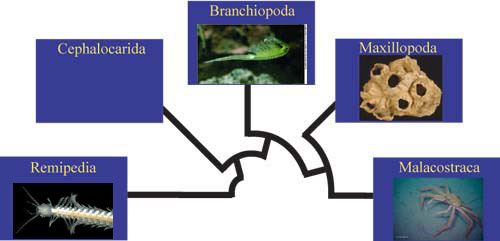Crustaceamorpha: Systematics


These pages present an accepted phylogeny, showing suggested relationships between living and fossil crustacean groups. Crustaceans are classified by the form of their body, the number of segments they possess, the presence or absence of a carapace, and the shape and function of their appendages. Most living and post-Cambrian fossil crustaceans fall into one of five groups, shown above. In discussing the groups we will emphasize the differences between groups based on these four aspects of morphology.
Keep in mind that the historical relationships among crustaceans
are complex, and scientists continue to study them. Although they possess an
exoskeleton, there are relatively few crustaceans represented in the fossil
record compared to groups like the Trilobita.
Maxillopoda and Malacostraca
are by far the most diverse of the groups and contain most animals you might
typically recognize as crustaceans. The majority of fossil forms are also members
of these two groups. Many fossil groups are difficult to place in the phylogeny
due to the limitations presented by fossil remains. This phylogeny will undoubtably
change as we find more fossils and learn more about each animal.

Brusca, R. C. and G. J. Brusca. 1990. Invertebrates. Sinauer Assoc., Inc. Sunderland, MA
Schram, F. R. 1986. Crustacea. Oxford University Press, Inc. New York
http://tolweb.org/tree?group=Crustacea&contgroup=Arthropoda&dynnodeid=2581